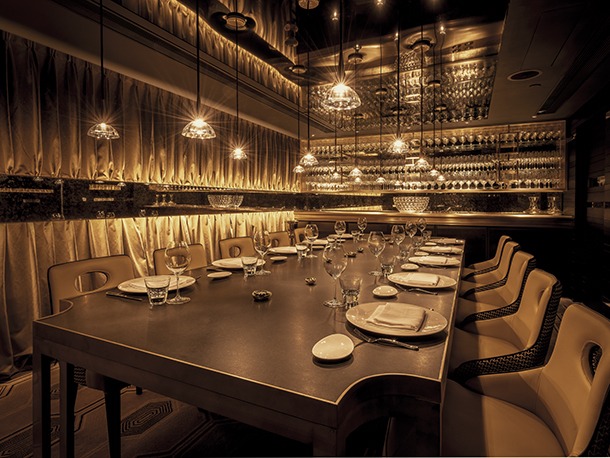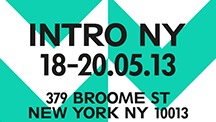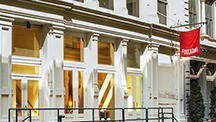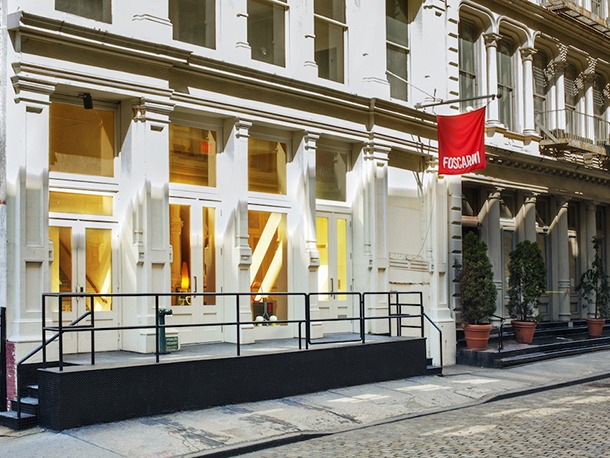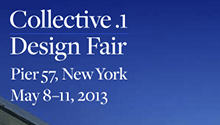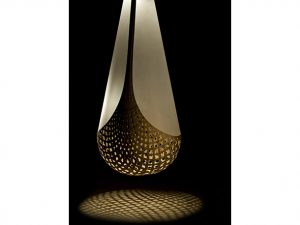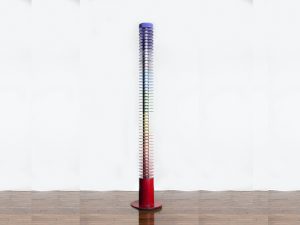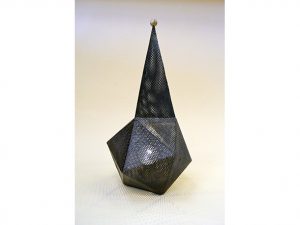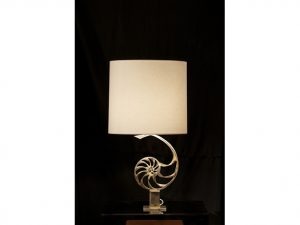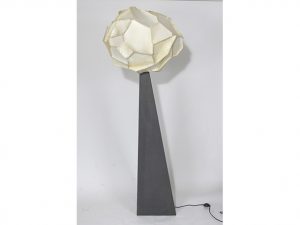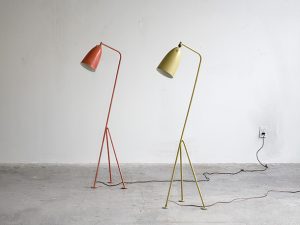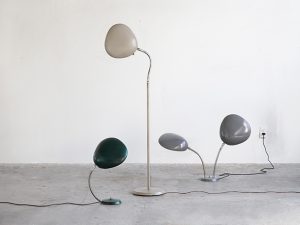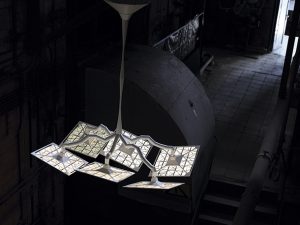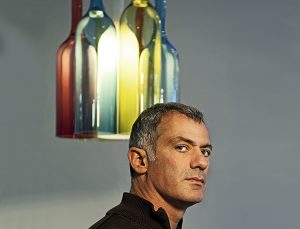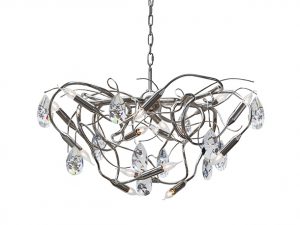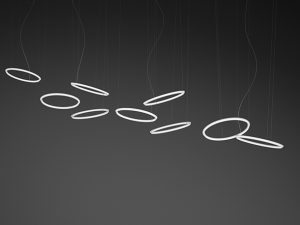Il Milione
Il Milione in Hong Kong is the first Asian venture from Michelin-starred chef Marco Gubbiotti. Operators the Savors Group wanted to create a chic, elegant setting befitting Gubbiotti’s high-class Italian cuisine and so turned to UK-based designLSM to produce interior design and brand identity for the new restaurant space. Associate, Anne Rhind and Architectural Director Simon Spiteri headed up the designLSM team, creating a luxurious theatrical scheme.
Diners enter the venue through a grand, golden doorway before climbing a narrow stairway towards the main dining room. On the way, they pass an intermediate level space that accommodates an informal bar area.
The main room is a windowless space that receives very limited levels of natural light. This, coupled with a low, fixed ceiling height, meant a number of visual tricks were required to ensure the space felt cosy, rather than confined. As part of this process, designLSM contacted Into Lighting for help bringing their designs to life.
The lighting design creates layers of warm white light that glows from concealed architectural details and from bespoke ‘halo’ feature fixtures.
The halo pieces cover the entire ceiling of the main room. Each comprises a shallow bowl shape, designed by designLSM and manufactured in China. Flexible Luci-Led strips, specified by Into, sit within each piece, concealed by a circular mirrored panel that helps to create the illusion of an increased ceiling height.
Into specified a DMX dimming control system from Lutron to ensure all LED lighting could be brighter during lunch service and then smoothly dimmed to a very low level in the evening.
Between the ceiling halos, surface mounted, low-glare fittings from Precision illuminate the dining tables. Long snoot and honeycomb louvre accessories ensure minimal glare, even when lighting tables at an angle.
To complement the circular ceiling pieces, Into drafted in UK-based luminaire producer Enigma Lighting to realise a series of decorative fixtures in line with designs by designLSM. Into provided the technical specification for these bespoke fittings with Enigma then developing the most suitable manufacturing techniques.
As well as delivering all pieces on budget and within the project’s tight lead time, Enigma had to ensure they were robust enough to survive the journey from the UK to Hong Kong, so specially designed timber packaging was developed to remove the risk of damage in transit.
The first of these pieces sits at one end of the restaurant bar. A steel framework with a powder coated gold finish supports a black dupion silk shade with gold silk lining. This structure is echoed and inverted in the design of three ceiling pieces that hang at the bar’s other end, though this time the frame is used to hold incandescent architectural tube lamps.
Within the main room, a line of custom brass lamp holders fitted with traditional-style filament bulbs hang above the server counter. Their twisted braid silk flexes provide a luxurious, period finish.
In one narrow section of the restaurant, a line of Artek Golden Bell A330s were used. These classic pendants in ring polished brass were originally designed by Alvar Aalto in 1954 and blend seemlessly into the rich, retro-inflected interior scheme.
The restaurant’s private dining room features Swarovski Sinar 100MM pendants. The precise faceting of the Sinar crystal reflector ensures light is distributed evenly below, while throwing scattered bands of light out around its edge.
As Spiteri notes, the high-end finish of Il Milione is particularly impressive given the international scope of the project and the difficulties posed by such a restrictive location.
“Overall, the project is a testament to the careful attention to detail given at site level and despite the challenges, the project has turned out beautifully and beyond everyone’s expectations,” he concludes.
www.designlsm.com
www.into.co.uk
Calf & Bloom
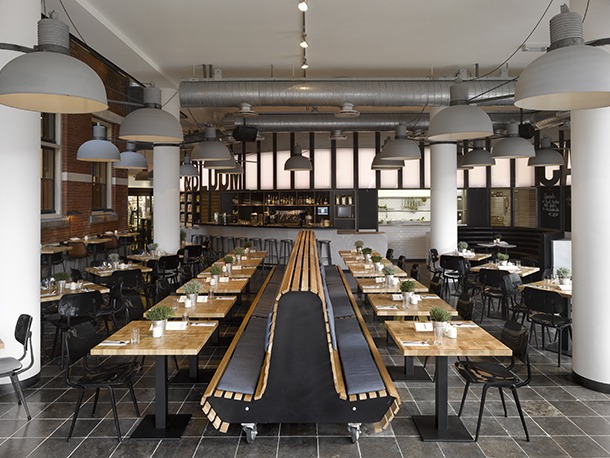
Situated on the ground floor of the Kalvertoren shopping centre on Amsterdam’s Singel canal, Calf & Bloom is a new eatery, created as a direct replacement for the site’s former incarnation, Replay Cafe. Far from making a few minor cosmetic changes, the venue’s owners opted for a total overhaul, drafting in Concrete Architects to create a new interior design and branding.
The new identity reveals a fresh set of aspirations for the venue. The new name - an anglicised amalgamation of two nearby landmarks, the Bloemenmarkt (flower market) and Kalverstraat (calf street) - gives the brand an international flavour. As well as indicating its own location in a flourish of American-style shorthand, it promotes the notion that this is a public space, a hidden indoor square in which to meet and relax with friends.
A wall of opaque light panels and louvers, set within a raw steel framework, separates the front of house and behind-the-scenes services, and includes a variety of functions by serving as a menu board, newspaper display and chalkboard. Sweeping between the venue’s front and rear facades, this wall with its illuminated panels underlines the ‘exterior space’ aesthetic, a concept further emphasised by silhouetting the Calf & Bloom name against the panes in large, steel lettering.
The new interior is given an industrial feel with the inclusion of high-bay style lighting. Measuring 78cm in diameter, these Lozz Extra Large shades are part of the Frezoli collection from TierlanTijn Lighting. TierlanTijn began producing the range four years ago, with each piece designed, developed and produced in-house at their Netherlands atelier. Each shade is formed from aluminium and suspended either from the ceiling by chains or from one of the venue’s cylindrical pillars using a metal bracket, custom made for the project by TierlanTijn.
Profile: Paul Cocksedge
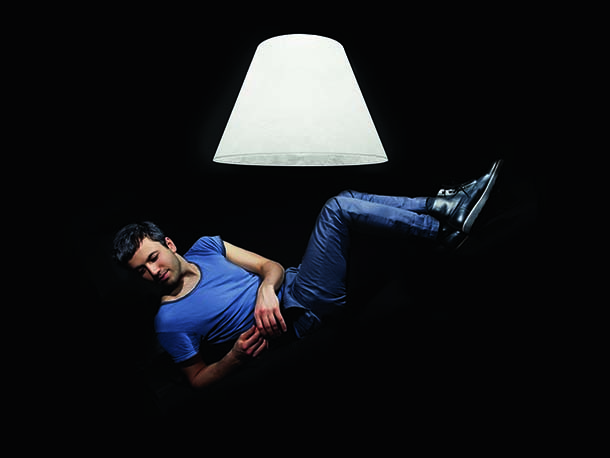
Amidst the wash of new lighting pieces introduced at Milan Design Week, there were few as visually intriguing as Shade. Created for Flos by London-based Paul Cocksedge Studio, Shade borrows from both the traditional suspended ceiling lamp and the floor lamp to create an object that exists in a category entirely of its own. Floating in mid air, its form is reassuringly familiar and yet the total absence of heavy power cables or support structure gives it an engaging surrealist edge.
Stripped of physical clutter, Shade allows the end user the freedom to place a light source wherever they want, without feeling tied to a building’s predetermined wiring grid. Easily installed, near invisible capillary-thin wires hold the paper shade section in place, while an LED floor fitting uplights the piece with a perfectly balanced, clean, warm white light.
Shade typifies the approach of Paul Cocksedge, a designer whose work spans architectural projects, design products and sculptural pieces – infusing each with a sense of simplicity, joy and wonder.
Though this is the first commercial piece to join Flos’s permanent portfolio, Cocksedge has previously collaborated with the Italian firm on a number of one-off works. With each encounter, the designer has been impressed by an openness to ideas and appreciation for his design intention, not least during discussions with Flos president Piero Gandini.
“Those meetings are the stand out moments for me,” says Cocksedge. “A lot of times when you meet someone who owns the manufacturing company, the discussion quickly goes to finance and numbers, whereas with Flos its always about creativity - how to keep the essence of the idea and translate that into an industrialised object. Flos are used to dealing with creative people - and they’re very creative themselves - so it’s a moment of two creative energies coming together; it’s kind of a designer’s dream.”
Importantly, for Cocksedge the process is not about producing ‘a lamp’, rather it is an expression of his on-going engagement with light as a material.
“For me I’ve just always been fascinated by light and its mechanics, by how it works in so many ways,” he explains. “It’s mysterious; it’s beautiful; it feeds us; it’s everything. So the objects that appear in my portfolio are just about showing people the wonders of that in different configurations. They’re not disconnected, they’re one, they’re a theme.”
PAST PROJECTS:
Bourrasque, 2011
Festival of Light, Hotel de Ville, Lyon, France
In his installation "Bourrasque", designer Paul Cocksedge combined his interest in the nature and morphology of paper with a subject that has long been an important element of his design work: light...
Cocksedge explained: "I've been fascinated for a long time by the various properties of light: how it emanates, how it diffuses, bends, reflects, and scatters. With these EL sheets I've been able to explore much further the idea of light as a flat object, as something touchable and malleable - not housed in a glass bulb or a neon strip, but an object you can bend and twist - and almost see it come alive in your hands..."
You might see these luminous sheets as documents that have suddenly escaped the confines of the offices and archives housed in this historic building, merrily fluttering on the wintry air... Equally, one might be reminded of the future of the paper medium itself, and specifically the new prototype developments in the physical shape of written media: thin, flexible tablets for downloading newspapers and magazines, perhaps even television and film.
As with all of Paul Cocksedge's work, "Bourrasque" showed his acute sense of the role of technology in design, combined with a characteristic lightness of touch, with elegance and joy.
Dimensions: Height 15 meters, length 25 meters
Material: Electroluminescent material
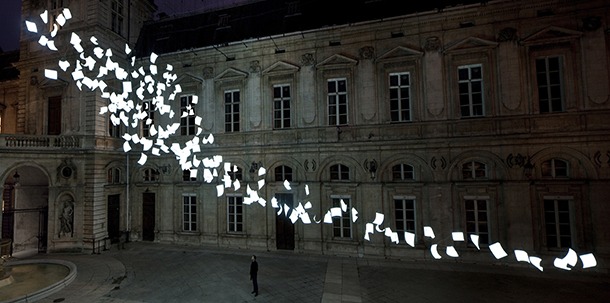
Crystallize, 2005
Designed for the Swarovski Crystal Palace Collection
‘Crystallize’ is a chandelier made from light and so when there is no light the chandelier disappears. Using lasers and crystals in perfect alignment, the iconic shape of a Swarovski crystal is drawn in mid air. At the heart of the chandelier is a single crystal, which sparkles as it catches the light.
Dimensions: Height range from 90cm to 180cm
Material: Crystals, laser module and glass
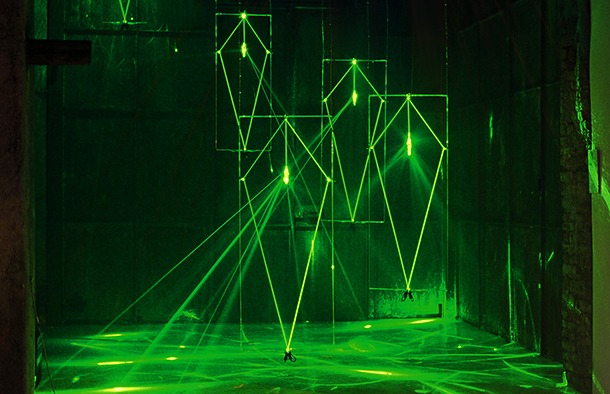
Kiss, 2009/2010
Commissioned by Comuni di Milano for Light Exhibition Design (LED)
Developing an idea of staging intimate encounters in the public sphere, ‘Kiss’ reinvented the ancient European tradition of kissing under a mistletoe and transforms it into an act of charity.
‘Kiss’ consisted of a huge LED canopy hanging above a stage from the centre dome of Galleria Vittorio Emanuele II and a large mistletoe.
When couples moved up to the stage and kiss, their connection activates a light sequence in the LED canopy, that changed colour in varying intensity, ultimately forming numbers in the sum of kisses given under the mistletoe. Each time this occured, in the spirit of the Christmas season, the sponsor UBI Banca, donated one Euro to CESVI, helping ease hunger in North Uganda.
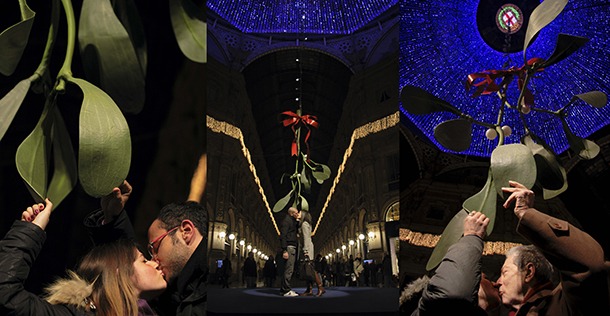
NeON, 2003
1st prize winner, 'The Bombay Sapphire Prize 2003', International Glass Design Award
NeON is a collection of hand made glass vessels filled with natural gas, charged with current and suspended. In day light they are translucent with a hint of natural colour. In darkness they have a unique and beautiful aesthetic all of their own with strikingly vivid colours. This product is purchased in clusters as the composition is integral to their design.
Dimensions: 10cm x10cm x 50cm (each vessel)
Material: Glass vessels filled with gas
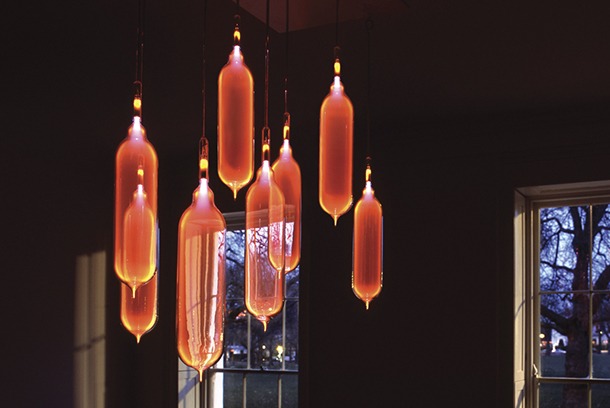
SESTOSENSO, 2011
Inspired by the quality and beauty of light and the astonishing new BMW 6 Series, the first BMW with Full-LED headlights, Paul Cocksedge has erected a seamless, curving, white wall extension to the Flos showroom and low-hanging red and white conical lamps. Stepping inside one of the impressive SESTOSENSO red lights, a video of the BMW 6 Series Coupe reveals itself on the vast white wall.
Dimensions: 24 metre curved wall, cone lights 870cm height, 760cm diameter
Material: Acrylic , LED
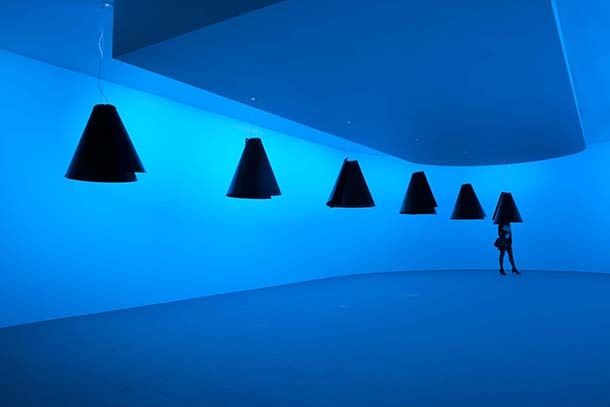
Sapphire Light, 2004
Originally commissioned by The Bombay Sapphire Foundation
The Saphire Light's design involved pouring gin and tonic into a light bulb-shaped vessel and shining UV light onto the chandelier. Switched on, the clear translucent liquid is transformed into an incredible glowing blue colour. The liquid becomes the light.
Dimensions: 30cm x 30cm x 30cm (glass globe)
Material: Glass, steel, UV LED
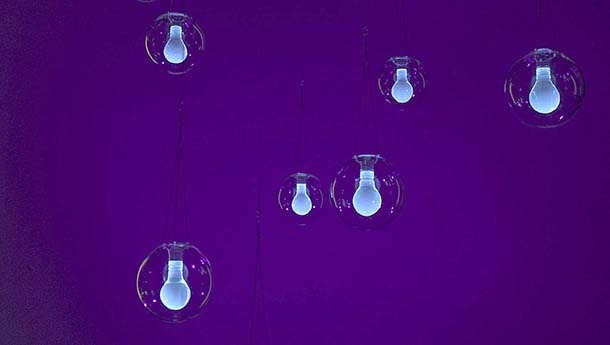
Substance over Style
“Most of us are not designing. We are styling, because we’re using imagery from the past.” This is one of many strong statements from Karim Rashid, taken from his thought provoking keynote talk at the ARC Show, part of The May Design Series.
These days it seems as though we have forgotten what design really means. We are using imagery of the past to design new products, meaning we use old paradigms to design new solutions. And yet when we do this we are not designing, we are merely styling. This results in products that look different and new, but in reality do nothing to help us solve the problems and obstacles we face. Nor do they enable us to have better experiences and interactions. Styling is about the need for products to be compelling for customers, not about solving fundamental problems with better products. Yet, too often, this is a large part of what so many companies call innovation. Companies seem to be in a race with their competitors to be fastest with new product launches, shouting just a bit harder about how great their products are and telling us how we all need to use their technology. But using new technologies does not automatically mean products are innovative. We need to understand that, while technology used the right way can enable the creation of brilliantly designed products, it is good design itself that is the main prerequisite to genuine innovation. For some reason the lighting industry is a boxed-in little world that designs around technology. This is what’s comfortable as it is what people in the industry have done for a long time. The problem is that this approach will not lead to the changes that are needed.
Many times I’ve heard companies and even so-called ‘designers’ present new products by touting them as great design. I’ve lost count on the number of new LED outdoor (street) lights, for example, that do the same thing as the ‘old’ lighting solutions. The only difference is the use of a new energy saving technology - LED. It doesn’t make the experience for everyone occupying that space any better. In some cases it makes the experience even worse. Think about our over-lit cities; these days it’s a rare thing to be able to see the natural beauty of thousands of stars that fill up our night sky.
Using safety as a way to tap into the psychology of fear in a bid to sell more products is also a bad move and won’t result in meaningful progress. It’s a missed opportunity as LED and OLED are technologies that can enable us to design better, meaningful solutions. For me and other industrial designers, these technologies offer amazing opportunities to design great products that are at the core of different lighting solutions. Saving energy is important, but it’s only a small part of what we need to consider when designing.
How does facade LED lighting full of flashy, moving advertising make our lives any better and our experiences more satisfying? If it means we have to have advertising on our buildings just to pay for these LED installations, we are doing something profoundly wrong as human beings. It means that we are just ending up with more stuff that screams for our attention. We have too much visual pollution already.
If there is one big lesson to take from the ARC Show and the talk Karim Rashid gave there, it is to understand how important it is to look at the broader design community, designers and design driven companies for a sense of direction that will propel the lighting industry into the place it wants to be.
The problem is that the visual appearance alone can be compelling enough for customers to buy a product, leaving them with stuff they don’t want or use after only a short time. Instead companies have a chance to be great, to take risks, to change things, to care. Be confident that customers and users will want to have your products. If a product is good, but not great, start over. It is that simple and, at the same time, that hard. For us as designers one of the challenges is to change the relationship and type of interactions we as humans have with technology and products. Outside the lighting industry there are some great designers and companies that have done this successfully; Apple, in the ways we interact and use consumer electronics, Nest with thermostats, VANMOOF with bicycles and Vitsoe with furniture. Lighting is so important in our everyday life, for the feel of everything around us - “The root of aesthetic is feeling,” as Karim Rashid put it1 - so how can we accept not to do better? We should start over. Start with a blank sheet, rethink and re-imagine the way we design products and solutions.
Making changes and executing them is scary, unpredictable and subject to failure. Well, embrace failure, because it is the best route to achieving success. We need to start asking questions like; why does this solution work this way? Why does a product have this look and feel? And how can it be better? Unless we take this design driven approach, we are in deep trouble. We need to stop designing the same things, restyled and repackaged. We need new structures and better-designed products. To start doing this, the lighting industry could do worse than looking outside its own industry. That is when innovation can really happen.
Citations: 1 - Karim Rashid, May Design Series keynote speech, ‘Analog vs Digital’.
Thomas Wensma is founder of Ambassador Design.
info@thomaswensma.nl
twitter.com/thomaswensma
www.thomaswensma.com
Folio: yoo Studio
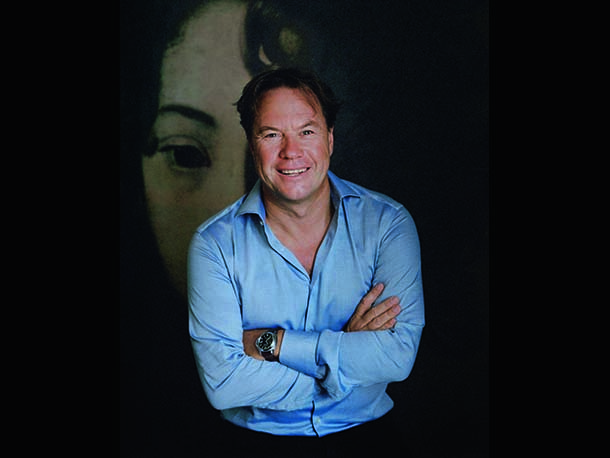
The yoo Studio is a unique design house with experience of cutting edge design in over 24 countries. Serving the yoo tribe internationally, the studio has completed individual residences and hotels as well as bringing to fruition the visions of Creative Directors Philippe Starck, Marcel Wanders, Jade Jagger and Kelly Hoppen.
Headed by Mark Davison, the studio’s experience is enhanced by its diversity of over 20 architects, interior and product designers, sourcing the best quality fittings and furniture from around the world to create interiors that are imaginative and individual. The studio has developed a unique understanding of global design, creating projects that respect and enliven their host location. “We’re not here to export European design around the world. We do a lot of research on the local context and weave that back in to the project,” says Davison.
The yoo Design Studio was originally established to service the ideas of its star designers providing what Davison calls “the glue between the designers and the developers.” Over time, however, the group has inevitably developed a unique intelligence and identity of its own, taking on residential and hotel interiors, restaurants and larger architectural projects.
www.yoo.com
Introducing INTRO NY
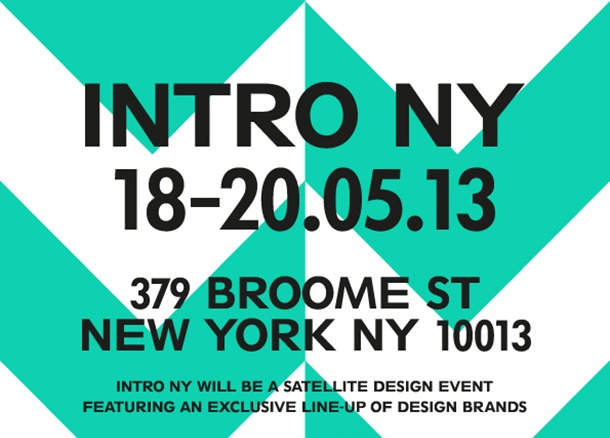
For those visiting New York for this year's Design Week, a new show has entered the mix. Supported by the organisers of designjunction and held by contemporary design agent smallpond INTRO NY will be a capsule event featuring products from carefully selected design brands. Among them will be darc favourites Resident and Castor Design (who collaborated with Quadrangle Architects on the lighting for their new Toronto HQ - featured in our latest issue).
INTRO NY will run from 18-20 May in the Nolita district.
Foscarini to open New York 'spazio'
Foscarini will use this months New York Design Week to open their latest showroom, Foscarini Spazio Soho. The launch follows hard on the heels of the brand’s Milan space launch in April.
Designer Ferruccio Laviani has designed custom display systems that can be changed at any time to fit the needs of the space. Like its Italian counterpart, the showroom aims to adopt an gallery-space identity and so opens with an installation by artist Stefano Arienti, whose piece Algae will fill part of the space.
Location: 17 Greene Street - between Canal and Grand Streets
Collective .1, New York
A mix of classic and contemporary decorative lighting pieces will be among the exhibits at Collective, a new design fair in New York City. The show will present a cohesive, curated selection from galleries around the world.
The inaugural edition, Collective .1, will coincide with Frieze New York and the May auctions and take place at Pier 57, a light-filled industrial space between the gallery hub of Chelsea and the vibrant Meatpacking District.
Pieces will include:
David Trubridge, Baskets of Knowledge, Kete Aronui, 2009, bamboo plywood with plastic clips, shrouds hand sanded PETG plastic, 33.5” x 82.5” (85cm x 209cm). Image courtesy of David Trubridge and Wexler Gallery.
Ico & Luisa Parisi, Iride Floor Lamp, c. 1970, enameled steel, aluminum, 71” H x 12” D (180cm H x 30.5cm D). Image courtesy of Nicholas Kilner.
Mathieu Mategot, Baghdad Lamp, 1953, perforated metal, 15” H x 7.5” D (43cm H x 19cm D). Image courtesy of Lost City Arts.
Maria Pergay, Lampe Nautile/Nautilus Lamp, c. 1972, silver-plated brass, 27.5” H with shade, base: 15” x 9” (70cm x 38cm x 23cm). Image courtesy of Demisch Danant.
Mauro Fabbro, Floor Lamp Scramble, 2009, parchment and metal, 80” H x 28” diam (203cm H x 71cm diam). Image courtesy of Casati Gallery.
"Grasshopper" floor lamp.
Designed by Greta Magnusson Grossman for Bergboms, Sweden, circa 1950. 14" L x 14" W x 48" H (FL287).
Photograph by Sherry Griffin
Cobra Lamp. Designed byGreta Magnusson Grossman, Photo by Sherry Griffin, Courtesy of R 20th Century
More information: www.collectivedesignfair.com
OBRANCH
OBRANCH combines both the traditional and modern. It is a classically designed chandelier using the newest OLED Tabola TG330 Destruct transparent lighting tiles. Each tile is 33 x 33cm and supplied by COMEDD, the Center for Organic Materials and Electronic Devices, based in Dresden.
Jar RBG
Arik Levy’s Jar RBG combines glass blowing techniques with the idea of RGB color mixing. A central piece in white glass acts as a large light bulb, illuminating the coloured jars that hang around it. Both transparent and lightweight in space, it is both efficient light source and delicately colourful piece.
Gaia
Named after the ancient Goddess of Earth, Gaia’s organically formed branches dance around the crystals, protecting them in a playful yet harmonious embrace. Rather than mere decoration, the Swarovski crystals become the heart of the piece, radiating an array of reflection and colour.
Halo
This light design floats in the air as harmonious lines or circles while generating sensations similar to those experienced in nature. The Halo lighting collection, designed by Martín Azúa for Vibia, evokes technology, design, art and life to create a family of pendant lights that is unique for its type.


